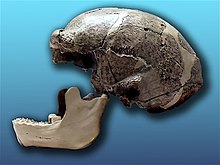Peking Man
From Wikipedia, the free encyclopedia
For the New Zealand pop band, see Peking Man (band).
| Peking man Temporal range: Pleistocene | |
|---|---|
 | |
| First cranium of Homo erectus pekinensis (Sinanthropus pekinensis) discovered in 1929 in Zhoukoudian, today missing (replica) | |
| Scientific classification | |
| Kingdom: | Animalia |
| Phylum: | Chordata |
| Class: | Mammalia |
| Order: | Primates |
| Suborder: | Haplorhini |
| Family: | Hominidae |
| Genus: | Homo |
| Species: | †H. erectus |
| Subspecies: | †H. e. pekinensis |
| Trinomial name | |
| Homo erectus pekinensis (Black, 1927) | |
| Synonyms | |
Sinanthropus pekinensis
| |
Peking Man (Chinese: 北京猿人; pinyin: Běijīng Yuánrén), Homo erectus pekinensis, is an example of Homo erectus. Discovered in 1923–27 during excavations at Zhoukoudian (Chou K'ou-tien) near Beijing (written "Peking" before the adoption of the Pinyinromanization system), China, in 2009 this group of fossil specimens dated from roughly 750,000 years ago,[1] and a new 26Al/10Be dating suggests they are in the range of 680,000–780,000 years old.[2][3]
Between 1929 and 1937, 15 partial crania, 11 mandibles, many teeth, some skeletal bones and large numbers of stone tools were discovered in the Lower Cave at Locality 1 of the Peking Man site at Zhoukoudian, near Beijing, in China. Their age is estimated to be between 500,000 and 300,000 years old. (A number of fossils of modern humans were also discovered in the Upper Cave at the same site in 1933.) The most complete fossils, all of which were calvariae, are:
- Skull II, discovered at Locus D in 1929 but only recognized in 1930, is an adult or adolescent with a brain size of 1030 cc. Skull II.jpg
- Skull III, discovered at Locus E in 1929 is an adolescent or juvenile with a brain size of 915 cc. Skull III.jpg
- Skulls X, XI and XII (sometimes called LI, LII and LIII) were discovered at Locus L in 1936. They are thought to belong to an adult man, an adult woman and a young adult, with brain sizes of 1225 cc, 1015 cc and 1030 cc respectively.[4] Skull X.jpg Skull XI.jpg Skull XII.jpg
- Skull V: two cranial fragments were discovered in 1966 which fit with (casts of) two other fragments found in 1934 and 1936 to form much of a skullcap with a brain size of 1140 cc. These pieces were found at a higher level, and appear to be more modern than the other skullcaps.[5] Skull V.jpg
Most of the study on these fossils was done by Davidson Black until his death in 1934. Pierre Teilhard de Chardin took over until Franz Weidenreich replaced him and studied the fossils until he left China in 1941. The original fossils disappeared in 1941, but excellent casts and descriptions remain.
No comments:
Post a Comment